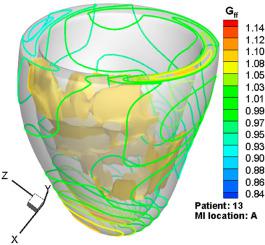Computers in Biology and Medicine ( IF 7.7 ) Pub Date : 2020-12-09 , DOI: 10.1016/j.compbiomed.2020.104168 Wenguang Li 1 , Hao Gao 2 , Kenneth Mangion 3 , Colin Berry 3 , Xiaoyu Luo 2

|
An outstanding challenge in modelling biomechanics after myocardial infarction (MI) is to estimate the so-called growth tensor. Since it is impossible to track pure growth induced geometry change from in vivo magnetic resonance images alone, in this work, we propose a way of estimating a surrogate or apparent growth tensor of the human left ventricle using cine magnetic resonance (CMR) and late gadolinium enhanced (LGE) images of 16 patients following acute MI. The apparent growth tensor is evaluated at four time-points following myocardial reperfusion: 4–12 h (baseline), 3 days, 10 days and 7 months. We have identified three different growth patterns classified as the Dilation, No-Change and Shrinkage groups defined by the left ventricle end-diastole cavity volume change from baseline. We study the- trends in both the infarct and remote regions. Importantly, although the No-Change group has little change in the ventricular cavity volume, significant remodelling changes are seen within the myocardial wall, both in the infarct and remote regions. Through statistical analysis, we show that the growth tensor invariants can be used as effective biomarkers for adverse and favourable remodelling of the heart from 10 days onwards post-MI with statistically significant changes over time, in contrast to most of the routine clinical indices. We believe this is the first time that the apparent growth tensor has been estimated from in vivo CMR images post-MI. Our study not only provides much-needed information for understanding growth and remodelling in the human heart following acute MI, but also identifies novel biomarker for assessing heart disease progression.
中文翻译:

心肌梗塞后左心室的表观生长张量–在人类首次自然史研究中
心肌梗死(MI)后生物力学建模的一个巨大挑战是估计所谓的生长张量。由于不可能仅通过体内磁共振图像来跟踪单纯的生长诱发的几何变化,因此在这项工作中,我们提出了一种使用电影磁共振(CMR)和晚期g估计人类左心室替代或表观生长张量的方法急性心肌梗死后16例患者的增强(LGE)图像。在心肌再灌注后的四个时间点评估表观生长张量:4–12 h(基线),3天,10天和7个月。我们已经确定了三种不同的增长模式,分别为膨胀,不变和收缩由左心室舒张末期腔体积定义的组从基线变化。我们研究了梗塞和偏远地区的趋势。重要的是,尽管没有变化该组的心室腔容积几乎没有变化,在梗死和偏远地区的心肌壁内均可见明显的重塑变化。通过统计分析,我们发现,与大多数常规临床指标相比,MI术后10天起,生长张量不变元可以用作有效的生物标志物,对心脏进行不利和有利的重塑,随时间变化具有统计学意义。我们相信,这是首次从心梗后体内CMR图像中估计表观生长张量。我们的研究不仅为了解急性心肌梗死后人心脏的生长和重塑提供了急需的信息,而且还鉴定了评估心脏病进展的新型生物标志物。



























 京公网安备 11010802027423号
京公网安备 11010802027423号